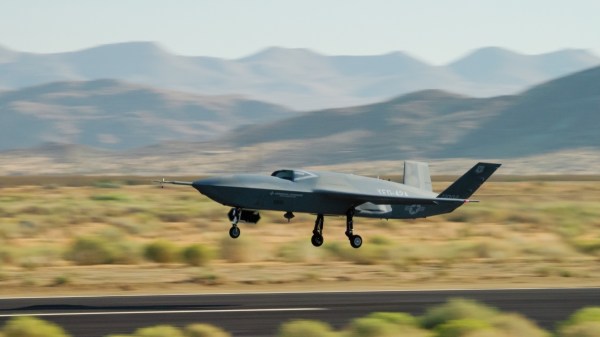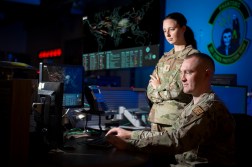Gen. Wilsbach, newly confirmed by the Senate, faces major challenges as Air Force chief

Gen. Kenneth Wilsbach, confirmed by the Senate on Thursday as Air Force chief of staff, will confront major modernization and readiness hurdles after taking charge as the service’s top officer.
Wilsbach — who recently served as commander of Air Combat Command and previously commanded Pacific Air Forces — has a new opportunity to shape the future force ahead of potential conflicts with high-tech adversaries such as China and address what some observers see as systemic problems.
Retired Lt. Gen. David Deptula, dean of the Mitchell Institute for Aerospace Studies, has noted that service leaders face “an incredible array of challenges.”
“By every meaningful measure, whether it’s age, size or readiness, the Air Force has declined to levels that frankly imperil its ability to prevail in major conflict,” he said during a podcast episode released Oct. 4. “Aircraft average over 30 years old, … two-thirds of the inventory first flew more than 50 years ago, its combat forces are less than half the size they were at the end of the Cold War, and the Air Force possesses only about one-third of the fighter capacity it fielded in its last major conflict. Readiness rates are so low that only a fraction of its pilot fighters and bombers are available on any given day. So, the incoming Air Force chief of staff must act decisively. His task will not be to manage decline, but to reverse it.”
Service chiefs generally serve four-year terms, although Gen. David Allvin, Wilsbach’s predecessor, is leaving the job after only two years in that position. Allvin was reportedly compelled to retire early by Pentagon leadership.
Analysts noted that solving some of the service’s top problems could be a lengthy process.
The new chief of staff is “not going to have the time to fix this Air Force crisis, but he can initiate a recovery. And that will require a solid, multiyear plan anchored on three imperatives: One, halting the decline of the Air Force, two, rebuilding capability and capacity, and three, restoring readiness,” Deptula said.
Heather Penney, director of research at the Mitchell Institute, added that there’s no quick fix.
“Let’s be clear. I mean, the crisis of the Air Force is in, has been decades in the making. It’s not going to be solved in months, or even perhaps one administration. It’s going to take multiple years to get the service healthy again,” she said on the podcast.
Air Force officials told lawmakers that the service needs to increase its fighter fleet by nearly 100 aircraft by 2030 and just under 300 platforms by 2025 to meet anticipated demands, according to news reports about an assessment that was recently submitted to Congress. However, budgetary and industrial constraints could imperil those goals, they noted.
Wilsbach indicated that he recognizes the fiscal challenges.
“We owe our Airmen a modernized and ready force. The biggest threat to those two things are fiscal constraints and fielding the US Air Force the Nation needs to confront the rapidly advancing threats; the associated risk we will incur with some of our foundational underpinnings of the force (infrastructure, IT, sustaining old weapons systems, obsolete training tools); retaining talent,” he told lawmakers in written responses to advance policy questions ahead of his confirmation hearing earlier this month.
The greatest challenge to Air Force readiness is “the tension between sustaining legacy systems and investing in future capabilities under constrained budgets,” according to Wilsbach.
“This imbalance risks hollowing the force and delaying transformation needed to meet pacing threats. If confirmed, I would address this by making hard divestment decisions and advocating for stable funding to support modernization and readiness simultaneously,” he wrote.
Wilsbach told senators that his “overarching goal” for Air Force transformation is to ensure the service can deter aggression and prevail in any conflict.
“This requires a carefully balanced approach, simultaneously maintaining the readiness of our current force while aggressively pursuing the modernization needed to stay ahead of emerging threats. In some areas of transformation we are further along than others. For instance, with respect to [high-value airborne assets], logistics, tankers, and broader deterrence, there remains work to be done,” he wrote.
“Homeland Defense is our top priority. At the same time, our Service needs to be able to project power into critical regions to prevent wars when possible, or to win them if and when we must. The Air Force must deliberately preserve our high-end readiness for the nation’s most consequential challenges, such as that posed by China in the Western Pacific. We must deliver warfighting advantages through both ‘stand-in’ and ‘stand-off’ capabilities, while increasing the tempo of our capability development to reestablish deterrence. Finally, we must advance our efforts in the areas of Long-Range Kill Chains, countering adversary long-range kill chains, and Air Base Air Defense,” Wilsbach added.
The Air Force needs to improve aircraft availability and training, and continue leveraging large-scale exercises and operational readiness inspections to enhance its preparedness and test new employment concepts, he noted.
As it moves to modernize, the service is investing in stealthy, next-generation manned platforms such as the B-21 bomber and F-47 fighter to stay ahead of high-end threats.
Wilsbach told lawmakers that the B-21 program — which has an industry team led by Northrop Grumman — “continues to make great progress.”
“We just accepted T-2 [the second B-21 test aircraft] which allows the government to further expand test capacity as we look to move on to mission system testing. This test data will prove our capability we promised to deliver to the warfighter. As we look to production, we are still working our way down the learning curve as we increase production capacity,” he wrote.
The F-47 has been described as a sixth-generation fighter. Earlier this year, President Donald Trump announced that Boeing had been selected to build the plane.
“In the few short months since the program was announced by the President, they have already begun to manufacture the first article and are executing within cost, schedule, and performance criteria. If confirmed, I will work with the Service Acquisition Executive and industry partners to meet program objectives and ensure we deliver the right capabilities to maintain air superiority against pacing threats around the globe,” Wilsbach wrote.
Meanwhile, the Air Force is also developing AI-enabled, jet-powered drones known as Collaborative Combat Aircraft, which are seen as a cost-effective way of boosting capacity and combat capabilities. Last year, General Atomics and Anduril received contracts for the first tranche, known as Increment 1.
Wilsbach told lawmakers that he views the CCA program as “foundational” to the Air Force’s future readiness.
“We are not just prioritizing it, we are aggressively accelerating the fielding of its first increment, with plans in place to initiate the second increment in early [fiscal 2026]. This initiative is pivotal: it leverages cutting-edge autonomy to create a powerful partnership with our crewed platforms, fundamentally reshaping our approach to air superiority,” he wrote.
Wilsbach continued: “Furthermore, CCA are purposefully designed for sustained affordability, driving down lifecycle costs through reduced operational demands, simplified logistics, and lower sustainment. I can confirm the program is currently performing well, meeting all cost, schedule, and performance criteria. If confirmed, my leadership will be committed to a collaborative approach with the Service Acquisition Executive and industry to not only meet our ambitious program objectives but to decisively deliver the advanced capabilities necessary to maintain unquestioned air superiority against any pacing threat, anywhere in the world.”
The Senate confirmed Wilsbach by voice vote, along with a slew of other military nominees.
Secretary of the Air Force Troy Meink has described Wilsbach as a “combat-tested aviator” with “the experience of leading combat forces around the globe.”
“I want to welcome General Kenneth Wilsbach as the 24th Chief of Staff of the Air Force! With his vast experience in the Pacific and as a commander at all levels, he is the right leader” for the Air Force, Meink wrote Thursday in a social media post on X.
“I also want to congratulate General Dave Allvin on a successful 39-year career in the Air Force! You were a great wingman as I came onboard as SecAF, and I wish you and your family all the best as you start your next adventure,” he added.






